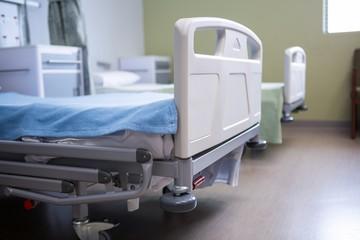Hospital Beds A Critical Component of Healthcare Facilities

The Evolution
Hospital bed design has evolved significantly over the years to meet the needs of patients and care providers. Early beds were basic wooden frames with thin mattresses that offered little support or comfort. In the 19th century, brass beds became popular, featuring head and foot rails made from the metal. However, these beds remained fairly rigid with no adjustability.
In the mid-20th century, these beds began incorporating technological advancements like adjustable heights and head and leg sections. Foam mattresses replaced innerspring versions for greater pressure redistribution. Modular designs allowed beds to convert between standard, intensive care, pediatric, bariatric, and other special utility functions. Controls were added to power common adjustments via push-button consoles installed on interchangeable bed ends or wall stations.
Today's beds offer highly advanced features. Hospital Beds are electric, featuring powered motors to raise, lower, and position sections at the touch of a button. Critical functions like CPR buttons allow quick dumping of the mattress during medical emergencies. Beds can wireless scale and report a patient's weight to track fluid status. Sophisticated monitoring systems integrate into bed frames to provide care staff continuous insight into vital signs.
Key Components
Modern hospital beds consist of several key components that work together to comfortably and securely support patients:
- Mattress: Pressure-reducing foam or air-based designs maximize skin integrity and comfort. Mattresses have fire-retardant covers and come in variable thickness and pressure specifications.
- Bed Frame: Steel frames provide strength and rigidity with adjustable features. Frames support height/movement controls, monitoring systems, railings, and other accessories.
- Braking/Steering System: Casters or wheels allow beds to be maneuvered safely. Central or individual wheel brakes lock all casters simultaneously.
- Controls: Push-button pendant or wall-mounted controls power various positions. Beds integrate call buttons, bed exiting alarms, scale functions, and monitoring systems.
- Railings: Variable-height railings secure patients prone to movement and at fall risk, while collapsing for easier access.
- Accessories: Over-bed tables, drawers, and trays provide surfaces. Oxygen tank mounts, IV poles, and suction holders support therapy needs.
Hospital Bed Categories and Special Functionality
Hospitals utilize various bed categories to meet diverse patient acuity levels and care needs:
Standard beds accommodate general medical, post-operative recovery, and observation patients. Features balance positioning support with easy mobility.
Critical care beds feature advanced monitoring integration and positioning for intensive care units. Beds convert between flat, chair, and other therapeutic positions.
Bariatric beds safely support patients weighing up to 1,000+ pounds with extra-wide frames and reinforced components.
Pediatric beds provide size and safety features appropriate for younger patients. Controls allow caregivers to power positioning changes.
Labor and delivery beds transform structure and functions for maternal patients through various birthing stages.
Emergency department stretchers transport and temporarily care for patients entering through the ER. Stretchers convert to beds with side rails.
Negative pressure beds circulate airflow beneath mattresses to prevent pressure injuries for at-risk patients.
Specialty bed considerations involve wound care, bariatric transport, air-fluidized therapy, radiolucent, and other categories.
The Importance of Hospital Bed Safety and Maintenance
Hospital bed safety remains a top priority area for healthcare facilities given the critical patient populations served. Regular maintenance and staff training help ensure safety:
- Beds undergo preventative maintenance like lubrication, part replacement, and function testing to catch issues before incidents occur.
- Facility safety officers work with biomedical engineers to audit beds, address recalls/advisories, and oversee repairs as issues emerge.
- Training covers proper bed positioning, braking/safety feature operation, transport protocols, fall prevention procedures, and emergency response drills.
- Technology upgrades keep beds operating on current firmware and software to benefit from ongoing safety improvements.
- Facilities inventory beds and track usage data to anticipate replacement needs based on usage thresholds factored by patient acuity levels.
As patient acuity rises within healthcare systems, hospital beds must evolve flexibly while maintaining strict safety standards. Proper maintenance, technology advancement, staff training, and replacement planning guarantee beds optimally support patients through all stages of care.
Get More Insights: Hospital Beds
For More Insights Discover the Report In language that Resonates with you
About Author:
Vaagisha brings over three years of expertise as a content editor in the market research domain. Originally a creative writer, she discovered her passion for editing, combining her flair for writing with a meticulous eye for detail. Her ability to craft and refine compelling content makes her an invaluable asset in delivering polished and engaging write-ups.
(LinkedIn: https://www.linkedin.com/in/vaagisha-singh-8080b91)
- Art
- Causes
- Crafts
- Dance
- Drinks
- Film
- Fitness
- Food
- Jogos
- Gardening
- Health
- Início
- Literature
- Music
- Networking
- Outro
- Party
- Religion
- Shopping
- Sports
- Theater
- Wellness
- IT, Cloud, Software and Technology


